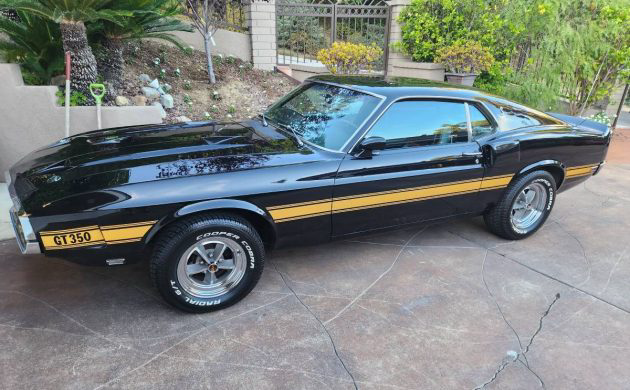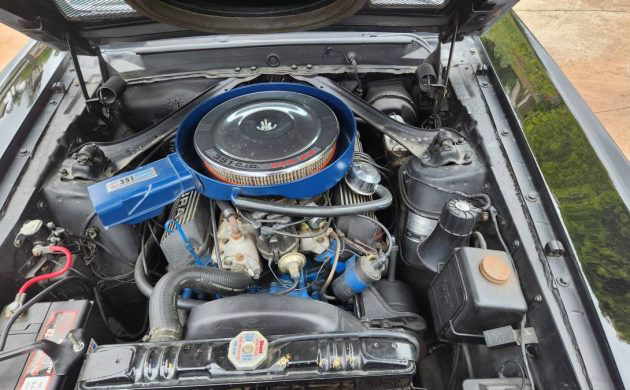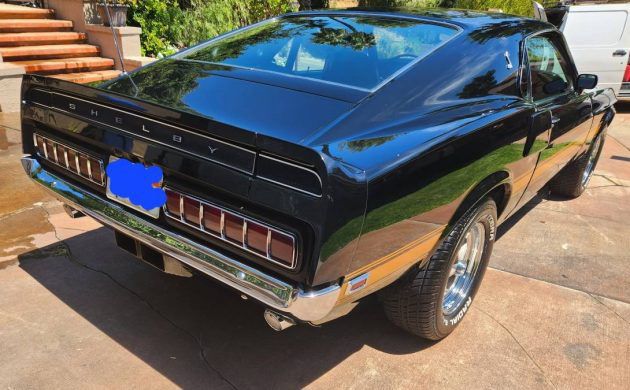Driver-Grade Survivor: 1969 Ford Shelby Mustang GT350
When it comes to desirable First Generation Mustangs, anything wearing a Shelby badge sits high on most lists. Produced in limited numbers, these classics perfectly blended performance and luxury to achieve legendary status. This 1969 Shelby GT350 is a perfect example of that philosophy. The seller doesn’t make bold claims about it being a show-quality classic. Rather, it is a high-end driver that can be enjoyed as its makers intended. Its next journey could be to a new home, so why not take a closer look to decide whether you need to make room in your garage for this GT350?
Carroll Shelby and Ford had worked hand-in-glove during the early days of the joint Mustang project, but cracks appeared in 1969. Ford took much of the development in-house, with Shelby having little input into the process. He cut his losses by mid-year, walking away from a project that produced some of America’s most iconic vehicles. This 1969 GT350 is a gem that has spent its life in a dry location. That makes its lack of rust unsurprising, with the seller confirming there is no history of prior rust repairs. The deep shine and lack of deterioration on the Raven Black paint suggest it has been protected from UV exposure, and the contrasting Gold stripes look crisp and clean. The exterior retains the additional scoops, spoilers, and other enhancements that were a hallmark of every Shelby from this era, and the beautiful five-spoke wheels look flawless.
The mechanical configuration guarantees that this GT350 will offer an enjoyable driving experience. The buyer receives a 351ci V8, a three-speed automatic transmission, and power assistance for the steering and front disc brakes. That V8 would have churned out 290hp and 385 ft/lbs of torque. That doesn’t make this the most potent vehicle to wear a Shelby badge, but its ability to produce a 15.5-second ¼-mile ET on its way to 122mph was considered very acceptable in 1969. The seller doesn’t specifically state that this GT350 is numbers-matching, although the listing conveys that impression. However, they do confirm that this is a turnkey proposition that runs and drives extremely well. If you are searching for a classic that can provide immediate enjoyment, this car ticks that box.
Identifying a single highlight on any classic of this caliber is challenging, but this GT350’s interior is mighty impressive. Its Black vinyl upholstered surfaces are excellent, with the carpet, dash, and faux woodgrain showing no evidence of deterioration or distress. The car retains its correct Shelby gauges, and I believe the factory radio is intact. It isn’t loaded with other factory options, but many will welcome the swing-away wheel. The seller includes a Marti Report that confirms that this Shelby is all that they claim.
With 1,085 Fastback examples sold, 1969 saw the lowest production total for the Shelby Mustang GT350 since 1965’s initial production run. These classics are eagerly sought by enthusiasts, which is reflected in the prices they achieve in the private market and at auction. The seller listed this GT350 here on Craigslist in La Habra, California. They set their price at $105,000 but might consider trades for an appropriate vehicle. It has only been on the market for a few days, but how quickly do you think it will find a new home?
Auctions Ending Soon
 2006 Ford Mustang Saleen S281 SCBid Now17 hours$15,000
2006 Ford Mustang Saleen S281 SCBid Now17 hours$15,000
 2002 Subaru Impreza WRXBid Now3 days$100
2002 Subaru Impreza WRXBid Now3 days$100
 1975 Chevrolet Corvette ConvertibleBid Now3 days$3,000
1975 Chevrolet Corvette ConvertibleBid Now3 days$3,000
 1964 Ford F-100 Camper CustomBid Now3 days$2,000
1964 Ford F-100 Camper CustomBid Now3 days$2,000
 2006 Jeep Wrangler SportBid Now5 days$10,500
2006 Jeep Wrangler SportBid Now5 days$10,500






Comments
Hard to go wrong w black paint on a musclecar. 😎 3600lbs, the great 351, Ford FMX autoloader, 3.25 std ring and pinion ⚙️ from the factory. 3.00 optional for longer legs on the highway.
And, of note, the 1970 Shelbys were leftover 69’s with only a minor change. So the low sales continued on these classics for whatever reason.
Sweet!! At a big name auction this should do well.
“…these classics perfectly blended performance and luxury to achieve legendary status.”
You’re aware that the original GT350 was aptly described by an contemporaneous enthusiast mag as a “brand-new clapped-out race car” right? The legendary status came from performance alone, largely due to lack of luxury. The GT350 didn’t really become luxury-oriented until 1969. By then the engines and suspensions were regular production Mustang parts. It was all show, with NoMoGo than a regular FoMoCo.
This is a great car, but an automatic Shelby is like a beige Superbird.
What a superlative example of this car! When these were new, they were an example of status. They were expensive and rare, but they were not competitive. Because of this they were not beat upon like Boss 302’s etc, and were able to survive the time warp and exist like this. if you have 6 figures to spend, this is how you show off when you show up. Just don’t lineup against a 15K Duster.
I think the reason this particular version of the Shelbys with the 351was a poor seller was that compared to the Camaro Z28s and the Firebirds, the 351 was a dog. I had one. I got rid of it 2 months later in August of 1970. It spent most of the time I owned it at Cruickshank Motors in Weston, Ontario, Canada being repaired under warranty. I loved driving it but I couldn’t get rid of it fast enough. The insurance was horrendous for a start. And it was much slower than my Ford Galaxie 500XL convertible equipped with a 390, cam, solid lifters, 750 Holley, Hurst/4spd and posi. No high performance car insurance for that car. By comparison, the Mustang was like taking the bus. The bus was more dependable.
The Windsor and Cleveland 351s installed in that vintage of Ford were considered duds at the time by drag racing enthusiasts. A 351 in a Shelby would have seemed like a sick joke to all but two of the guys I raced with.
The big block Mustangs regardless of edition, all shared a fatal flaw as far as market success went. The big blocks were too big for the engine bays they were stuffed into. The Engine had to be partially disassembled and lifted clear of the engine bay to change the spark plugs. That news spread like wildfire at the time and was good for a lot of laughs over a hamburger and a Coke. We heard that if you wanted to tune your car up yourself, you needed a flat driveway/garage, an engine hoist and a lot of time that could have been spent doing something else. In those days, there weren’t nearly as many garages per capita as there are now. That reduced the number of potential buyers substantially. No one had an engine hoist. Lifting an engine meant building a tripod out of 16′ lengths of 4x4s and employing a block and tackle. Car maintenance at home was pretty crude in those days.
Then there was the fact that Ford’s motors didn’t really shine performance-wise until the speedometer needle reached the right side of the dial. Say around 80 mph, those engines really started to haul ass. But most street races happened at lower speeds due to the irregularities of city streets and not being drag strips. So Fords and Mustangs in particular didn’t generally fare well in street races. By 1970, Camaros and just about everything else were eating them for breakfast.
Watching those Mustangs from the bleachers gave you a real sense of how those Mustangs performed. When the light turned green and the cars launched, GMs, Chryslers and AMCs would be off like rockets leaving the Fords to lumber down the track. Then about an eigth into it, the Fords would seem to come alive and the competition would look like they were slowing to park. That was great to watch at the drag strip but it didn’t work well on the street. That hurt Ford’s image at the Hamburger joints all over North America.
Shelbys have since become famous in collector circles but at the time they were built, hardly anyone knew about them. Word didn’t spread then as fast as it does now. The only way to learn about these cars for most people was to read about them in car magazines. But even then, most drivers weren’t spending money on car magazines. Those that did, mostly just looked at the photographs and didn’t read the articles much beyond the headlines and the captions under the photos.
Certainly, there were those who actually did read the articles. If they did and kept track of how the cars were said to perform they were met with mixed messages. By the mid-sixties, it was becoming known that a number of the cars being supplied to be tested by the magazines were “ringers”.
There were subtle ways of altering performance to improve ETs. A lot of the articles were upfront about what could be done – after all, that’s what sold the enthusiasts and became fodder for the magazines to hype the rivalries.
But in the end, it was pretty clear that GM and Chrysler were mostly socking it to Ford and that has persisted to this day.
What the Mustangs had going for them was that they were beautiful cars to drive and even better to look at as a commuter. Most commuters didn’t need big blocks or Shelbys. A Mach I Mustang was good enough to get them back and forth to work even if the nameplate was a performance misrepresentation. So the 351 became a bread and butter engine that couldn’t stand up to a Camaro with a 350 in it. Bottom line? Who really needed a Shelby? Not many people could answer that question in the affirmative at the time.
Don’t get me wrong, I’m not anti-Ford. It’s just too bad for the entire muscle car scene that computers, the internet, iphones, Google and Facebook weren’t in full flight back in the day. We’d have a much better record of the era and maybe the sport of drag racing would be in better shape today than it is. With those tools, the entire muscle car scene could have been enhanced and enjoyed to greater depth.
Today, cars like this Shelby are the modern version of art. Before there were cameras, paintings were how certain events were recorded and made public. Those paintings remain a symbol and the currency of wealth. But vintage performance cars have to a large extent replaced paintings and other forms of art as valuable collectibles that inspire worthy daydreams.
I love a black sports car but if l were the owner and wanted to move this car I’d strip it down and paint it one of your more traditional colors for a Shelby. That’s what l’m seeing. Beautiful car though.Red White Blue Gold I could see.